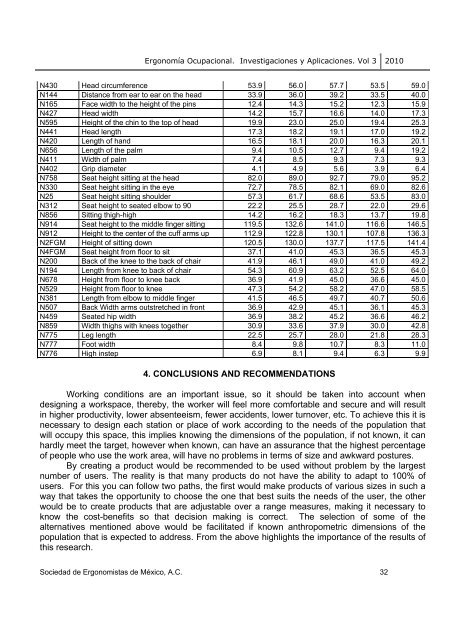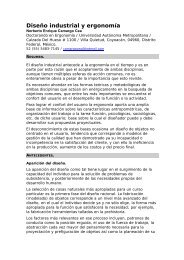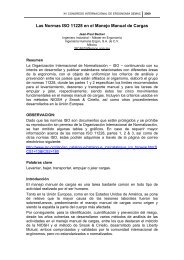ERGONOMÍA OCUPACIONAL - SOCIEDAD DE ERGONOMISTAS ...
ERGONOMÍA OCUPACIONAL - SOCIEDAD DE ERGONOMISTAS ...
ERGONOMÍA OCUPACIONAL - SOCIEDAD DE ERGONOMISTAS ...
Create successful ePaper yourself
Turn your PDF publications into a flip-book with our unique Google optimized e-Paper software.
Ergonomía Ocupacional. Investigaciones y Aplicaciones. Vol 3 2010<br />
N430 Head circumference 53.9 56.0 57.7 53.5 59.0<br />
N144 Distance from ear to ear on the head 33.9 36.0 39.2 33.5 40.0<br />
N165 Face width to the height of the pins 12.4 14.3 15.2 12.3 15.9<br />
N427 Head width 14.2 15.7 16.6 14.0 17.3<br />
N595 Height of the chin to the top of head 19.9 23.0 25.0 19.4 25.3<br />
N441 Head length 17.3 18.2 19.1 17.0 19.2<br />
N420 Length of hand 16.5 18.1 20.0 16.3 20.1<br />
N656 Length of the palm 9.4 10.5 12.7 9.4 19.2<br />
N411 Width of palm 7.4 8.5 9.3 7.3 9.3<br />
N402 Grip diameter 4.1 4.9 5.6 3.9 6.4<br />
N758 Seat height sitting at the head 82.0 89.0 92.7 79.0 95.2<br />
N330 Seat height sitting in the eye 72.7 78.5 82.1 69.0 82.6<br />
N25 Seat height sitting shoulder 57.3 61.7 68.6 53.5 83.0<br />
N312 Seat height to seated elbow to 90 22.2 25.5 28.7 22.0 29.6<br />
N856 Sitting thigh-high 14.2 16.2 18.3 13.7 19.8<br />
N914 Seat height to the middle finger sitting 119.5 132.6 141.0 116.6 146.5<br />
N912 Height to the center of the cuff arms up 112.9 122.8 130.1 107.8 136.3<br />
N2FGM Height of sitting down 120.5 130.0 137.7 117.5 141.4<br />
N4FGM Seat height from floor to sit 37.1 41.0 45.3 36.5 45.3<br />
N200 Back of the knee to the back of chair 41.9 46.1 49.0 41.0 49.2<br />
N194 Length from knee to back of chair 54.3 60.9 63.2 52.5 64.0<br />
N678 Height from floor to knee back 36.9 41.9 45.0 36.6 45.0<br />
N529 Height from floor to knee 47.3 54.2 58.2 47.0 58.5<br />
N381 Length from elbow to middle finger 41.5 46.5 49.7 40.7 50.6<br />
N507 Back Width arms outstretched in front 36.9 42.9 45.1 36.1 45.3<br />
N459 Seated hip width 36.9 38.2 45.2 36.6 46.2<br />
N859 Width thighs with knees together 30.9 33.6 37.9 30.0 42.8<br />
N775 Leg length 22.5 25.7 28.0 21.8 28.3<br />
N777 Foot width 8.4 9.8 10.7 8.3 11.0<br />
N776 High instep 6.9 8.1 9.4 6.3 9.9<br />
4. CONCLUSIONS AND RECOMMENDATIONS<br />
Working conditions are an important issue, so it should be taken into account when<br />
designing a workspace, thereby, the worker will feel more comfortable and secure and will result<br />
in higher productivity, lower absenteeism, fewer accidents, lower turnover, etc. To achieve this it is<br />
necessary to design each station or place of work according to the needs of the population that<br />
will occupy this space, this implies knowing the dimensions of the population, if not known, it can<br />
hardly meet the target, however when known, can have an assurance that the highest percentage<br />
of people who use the work area, will have no problems in terms of size and awkward postures.<br />
By creating a product would be recommended to be used without problem by the largest<br />
number of users. The reality is that many products do not have the ability to adapt to 100% of<br />
users. For this you can follow two paths, the first would make products of various sizes in such a<br />
way that takes the opportunity to choose the one that best suits the needs of the user, the other<br />
would be to create products that are adjustable over a range measures, making it necessary to<br />
know the cost-benefits so that decision making is correct. The selection of some of the<br />
alternatives mentioned above would be facilitated if known anthropometric dimensions of the<br />
population that is expected to address. From the above highlights the importance of the results of<br />
this research.<br />
Sociedad de Ergonomistas de México, A.C. 32




